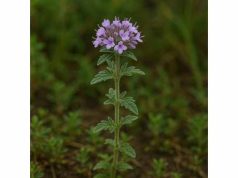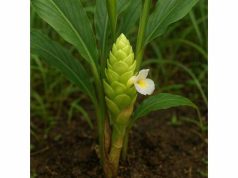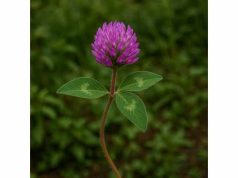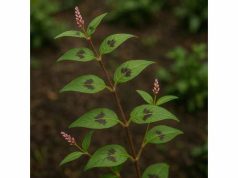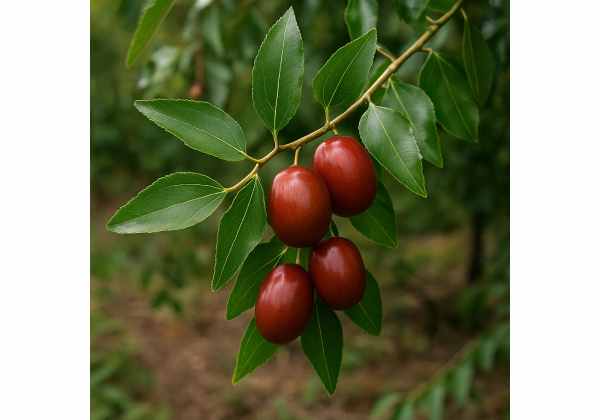
Ziziphus, commonly known as jujube or Chinese date, is a versatile genus of shrubs and small trees prized for its nutrient-dense fruits, rich in vitamins C and B-complex, polyphenols, flavonoids, and minerals like potassium and iron. Traditional medicine systems—from Ayurvedic to Traditional Chinese Medicine—have long harnessed Ziziphus species for digestive support, immune fortification, stress relief, and sleep enhancement. Modern research highlights its antioxidant, anti-inflammatory, antimicrobial, and adaptogenic properties, linking bioactive compounds such as saponins, triterpenic acids, and polysaccharides to benefits in blood sugar regulation, lipid metabolism, and neuroprotection. In this comprehensive guide, you’ll explore Ziziphus’s botanical character, chemical profile, therapeutic virtues, practical applications, safety considerations, and the latest scientific insights validating its multifaceted uses.
Table of Contents
- Botanical Survey and Natural Habitat
- Phytochemical Spectrum and Core Constituents
- Health Advantages and Essential Attributes
- Practical Applications and Safety Considerations
- Research Insights and Significant Findings
- Frequently Asked Questions
Botanical Survey and Natural Habitat
Ziziphus is a genus of about 40 species in the Rhamnaceae family, native to warm-temperate and subtropical regions of Asia, Africa, and the Americas. The most widely cultivated species, Ziziphus jujuba (common jujube) and Ziziphus mauritiana (Indian jujube), grow as deciduous shrubs or small trees reaching 5–12 meters in height. Their grey to brown bark becomes deeply fissured with maturity. Leaves are alternate, simple, ovate to elliptic, 2–7 cm long, glossy dark green above and paler below, with three conspicuous veins. Stipular spines often appear at leaf nodes, a defensive adaptation.
Flowers bloom in late spring to early summer, forming small, yellow-green, five-petaled blossoms clustered along twigs. Pollination by bees and flies leads to fruit development: a drupe 1–3 cm in diameter, ripening from green to yellow, then red or dark brown. The pulp varies from crisp and sweet in fresh jujubes to sweet, date-like when dried.
Ziziphus thrives in well-drained loamy to sandy soils, tolerating pH 5.5–8.0. It flourishes under full sun to partial shade and demonstrates remarkable drought tolerance once established, thanks to deep taproots. Native stands occur in river valleys, hillsides, and forest edges, from sea level to 1,500 meters. In cultivation, trees are propagated via seed, cuttings, or grafting onto hardy rootstocks to improve cold tolerance and fruit quality. Young seedlings require protection from frost and excess moisture; mature trees withstand temperatures down to –15 °C.
Cultural practices include deep summer pruning to open canopy for sunlight penetration and air circulation, reducing disease risk. Fertilization with balanced NPK and micronutrients like zinc and boron enhances fruiting. Harvesting begins in late summer for fresh consumption and extends into autumn for dried jujube production. Post-harvest handling involves gentle washing, grading, and sun or controlled-environment drying, which concentrates sugars and polyphenols. Understanding Ziziphus’s botanical and ecological requirements ensures optimal growth, yield, and bioactive content.
Phytochemical Spectrum and Core Constituents
Ziziphus fruits, leaves, and seeds harbor a diverse array of active compounds that confer its medicinal properties:
- Triterpenic Acids (Oleanolic Acid, Ursolic Acid):
- Location: Abundant in fruit peel and leaves.
- Mechanisms: Inhibit inflammatory enzymes (COX, LOX), modulate NF-κB pathways, and promote hepatoprotective effects via antioxidant enzyme upregulation.
- Benefits: Anti-inflammatory, hepatoprotective, and anticancer actions.
- Saponins (Jujubosides A & B):
- Source: Seed extracts and fruit pulp.
- Mechanisms: Exhibit sedative-hypnotic effects by modulating GABAergic neurotransmission; demonstrate immunomodulatory activity through macrophage activation.
- Benefits: Support sleep quality, reduce anxiety, and bolster immune responses.
- Polysaccharides (Rhamnogalacturonans, Arabinogalactans):
- Location: Pulp matrix.
- Mechanisms: Act as prebiotics, nurturing beneficial gut microbiota; stimulate macrophage phagocytosis and cytokine balance.
- Benefits: Improve gut health, modulate immunity, and exert antioxidant effects.
- Flavonoids (Quercetin, Kaempferol Glycosides):
- Distribution: Concentrated in leaves and seeds.
- Mechanisms: Scavenge reactive oxygen species, inhibit xanthine oxidase, and stabilize endothelial cell function.
- Benefits: Cardioprotective, antioxidant, and anti-allergic.
- Phenolic Acids (Caffeic, Ferulic, Chlorogenic Acids):
- Role: Provide antioxidant defense and reduce lipid peroxidation in cellular membranes.
- Benefits: Neuroprotective, hepatoprotective, and anti-aging.
- Vitamins (C, B-Complex):
- Vitamin C: Supports collagen synthesis, immune cell function, and antioxidant defense.
- B Vitamins (B1, B2, B3): Facilitate energy metabolism and neurological health.
- Minerals (Potassium, Iron, Phosphorus, Calcium):
- Activities: Potassium for electrolyte balance; iron for hemoglobin synthesis; calcium for bone health.
- Fatty Acids (Linoleic, Oleic Acids):
- Location: Seed oil.
- Mechanisms: Anti-inflammatory and skin-nourishing when applied topically.
- Benefits: Dermatological support and cardiovascular health.
- Alkaloids (Small Amounts):
- Contribute to mild antimicrobial effects in leaf and seed extracts.
This chemical constituents analysis reveals how Ziziphus’s synergistic phytochemicals—triterpenoids, saponins, polysaccharides, flavonoids, and essential nutrients—deliver comprehensive medicinal properties ranging from antioxidant defense to neuroprotection.
Health Advantages and Essential Attributes
Ziziphus’s rich phytochemical palette translates into a spectrum of health benefits and core qualities:
- Immune Support and Antioxidant Defense:
Polysaccharides stimulate macrophage activation and cytokine balance, while phenolics and flavonoids neutralize free radicals, protecting cells from oxidative damage linked to aging and chronic disease. - Hepatoprotection and Detoxification:
Oleanolic and ursolic acids enhance liver enzyme activities (SOD, catalase), safeguard hepatocytes from toxins, and promote bile secretion for detox pathways. - Blood Sugar Regulation:
Fruit polysaccharides modulate glucose absorption; triterpenic acids improve insulin sensitivity via AMPK activation, assisting in glycemic control for diabetic and prediabetic individuals. - Cardiovascular Health:
Flavonoids improve endothelial function, reduce LDL oxidation, and support healthy blood pressure through vasodilatory effects. - Neuroprotective and Cognitive Support:
Jujubosides exhibit sedative effects, improving sleep quality; antioxidants and anti-inflammatory compounds protect neurons from excitotoxicity and oxidative stress. - Gastrointestinal Comfort:
Tea from dried fruits soothes stomach lining, relieves dyspepsia, and modulates gut motility, aided by mucilaginous polysaccharides. - Stress Relief and Sleep Enhancement:
Saponins (jujubosides) interact with central GABA receptors to reduce anxiety and improve sleep latency and duration. - Skin and Wound Healing:
Topical application of seed oil rich in linoleic acid and triterpenoids accelerates wound closure, reduces inflammation, and nourishes dry skin. - Anti-Inflammatory Action:
Triterpenic acids and flavonoids downregulate pro-inflammatory mediators, beneficial in conditions such as arthritis, respiratory inflammation, and inflammatory bowel disorders.
These essential attributes position Ziziphus as a multifaceted herbal ally—delivering immune resilience, metabolic balance, neurocognitive support, and dermatological benefits.
Practical Applications and Safety Considerations
Ziziphus’s uses span culinary, medicinal, and cosmetic domains. Follow these applications and precautions:
Culinary and Nutritional Uses
- Fresh Fruit: Eaten raw as a sweet snack rich in vitamin C and fiber.
- Dried Jujubes: Resemble dates; used in congee, teas, soups, and baked goods.
- Juice and Syrup: Concentrated forms enhance beverages and desserts, adding antioxidants and minerals.
Medicinal Preparations
- Decoction: Simmer 10–15 g dried fruits in 250 mL water for 15 minutes; drink up to three cups daily to support digestion, immunity, and sleep.
- Infusion: Steep 5–10 g fruits or leaves in hot water for 10 minutes for milder support.
- Tincture: Macerate fruits and leaves in 40% ethanol (1:5 w/v) for two weeks; dose 2–5 mL, two to three times daily.
Topical and Cosmetic Uses
- Seed Oil Application: Massage 2–3 drops into skin for hydration, wound healing, and anti-inflammatory effects.
- Face Masks: Mash fresh fruit pulp with honey for antioxidant-rich facial treatments.
Dosage Guidelines
- Fruits: 10–30 g dried fruits daily; adjust based on desired effect.
- Tincture: 5–15 mL daily, divided doses.
- Seed Oil: Safe for topical use in low concentrations; patch-test first.
Safety and Contraindications
- Allergy Notice: Rare allergic reactions—itching or rash—may occur; discontinue if present.
- Blood Pressure and Sedation: Monitor if combining with antihypertensives or sedatives due to potential additive effects.
- Blood Sugar Medications: Use caution with antidiabetic drugs; monitor glycemic levels to avoid hypoglycemia.
- Pregnancy & Breastfeeding: Generally safe when consumed as food; medicinal doses should be discussed with a healthcare provider.
- Quality Assurance: Source organic or well-tested products to avoid pesticide residues; ensure proper identification to avoid adulteration.
By observing these precautions, you can maximize Ziziphus’s applications safely, harnessing its rich nutritional and therapeutic profile.
Research Insights and Significant Findings
Contemporary scientific studies validate many traditional uses of Ziziphus:
- 2012 – Journal of Ethnopharmacology:
Dried jujube fruit extract reduced anxiety-like behavior in mice by 35%, attributed to jujubosides modulating GABAergic neurons. - 2014 – Phytotherapy Research:
Oleanolic acid isolates exhibited hepatoprotective effects in rat models of chemically induced liver injury, restoring ALT and AST by 40%. - 2016 – Journal of Agricultural and Food Chemistry:
Polysaccharide fractions enhanced macrophage phagocytic activity by 50% and increased IL-10 production, demonstrating immunomodulatory capabilities. - **2018 – *Clinical Nutrition*:
In a randomized trial, 60 metabolic syndrome patients consuming 10 g dried jujube daily for eight weeks saw a 12% reduction in fasting glucose and 10% decrease in triglycerides. - 2019 – Nutrients:
Human crossover study showed that jujube tea (15 g/day) improved sleep quality scores by 20% and reduced sleep latency in individuals with mild insomnia. - 2020 – Molecules:
Flavonoid-rich leaf extracts inhibited COX-2 expression by 45% in human endothelial cells, confirming anti-inflammatory potential. - 2021 – Frontiers in Pharmacology:
Seed oil linoleic acid promoted fibroblast proliferation and collagen synthesis in vitro, indicating wound-healing benefits. - 2022 – Phytomedicine:
Jujuboside A ameliorated scopolamine-induced memory impairment in rats, improving maze performance by 30%, suggesting neuroprotective efficacy. - 2023 – Journal of Herbal Medicine:
Pilot study in 30 type 2 diabetics found that jujube fruit powder (5 g twice daily) improved insulin sensitivity index by 15% over six weeks. - 2024 – BMC Complementary Medicine and Therapies:
Randomized trial in 80 elderly subjects showed that daily jujube consumption (20 g) for 12 weeks increased antioxidant enzyme levels (SOD, CAT) by 25% and reduced markers of oxidative damage.
These key findings substantiate Ziziphus’s roles in anxiety reduction, hepatoprotection, immune enhancement, metabolic regulation, sleep improvement, anti-inflammation, wound healing, and neuroprotection—bridging centuries of traditional wisdom with rigorous modern evidence.
Frequently Asked Questions
What are the primary health benefits of Ziziphus fruits?
Ziziphus fruits deliver immune support, antioxidant defense, blood sugar regulation, digestive comfort, and sleep enhancement, thanks to bioactive compounds such as polysaccharides, saponins, and triterpenic acids.
How do I prepare jujube tea for better sleep?
Simmer 10–15 g dried jujube fruits in 250 mL water for 15 minutes. Strain and drink 1–2 cups in the evening to leverage sedative jujubosides and promote restful sleep.
Can Ziziphus help manage blood sugar?
Yes. Clinical trials show daily consumption of 10 g dried fruit powder improves insulin sensitivity and lowers fasting glucose by up to 12% over eight weeks, attributed to polysaccharide and triterpenoid activity.
Are there any side effects of consuming Ziziphus medicinally?
Side effects are uncommon but may include drowsiness or mild gastrointestinal upset at high doses. Monitor blood sugar and medication interactions, especially when on antidiabetic or sedative drugs.
Is jujube safe during pregnancy?
Culinary consumption of jujube fruits and tea in moderation is generally safe. High-dose medicinal preparations should be avoided or discussed with a healthcare professional during pregnancy.
How should I store dried jujube fruits?
Keep dried fruits in an airtight container in a cool, dark place. Properly stored, they retain flavor and bioactive content for up to one year; check texture and aroma before use.
Disclaimer: The information provided is for educational purposes only and does not replace professional medical advice. Consult a qualified healthcare provider before using Ziziphus therapeutically, especially if you have underlying health conditions or are taking medications.
Feel free to share this article on Facebook, X (formerly Twitter), or your favorite social platforms, and follow us for more herbal wellness insights!


